Lorsque l’on a imprimé et collé cette étiquette sur ce vin, se doutait-on que l’expression "vin de garde" serait poussée à son paroxysme, puisque nous l’avons bu 142 ans plus tard !
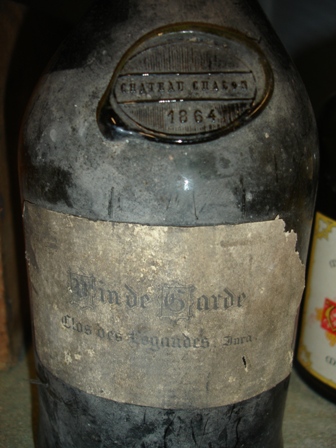
Lorsque l’on a imprimé et collé cette étiquette sur ce vin, se doutait-on que l’expression "vin de garde" serait poussée à son paroxysme, puisque nous l’avons bu 142 ans plus tard !

Lorsque j’ai annoncé l’arrivée de Londres de la bouteille de Lafite 1865, voici ce qu’a écrit Robert Parker sur son forum :
Well a magnum of 1864 Lafite from the Glamis castle …original cork…served at the unforgettable Robuchon dinner in Tokyo in December,2004, brought me to tears….and I don’t cry easily… not with respect to wine…..I think Broadbent had called it the "greatest wine of the 19th century’…..but he couldn’t have tasted every wine made that century….as I recall…even Robuchon was misty-eyed over this amazing wine……hope your bottle is as memorable…
ça fait plaisir !
Ma cave a été filmée par une équipe de Télé Monte-Carlo. Apparemment le sujet passera en juillet 2006, et sera repris sur la chaîne Odyssea. Le cameraman est un amoureux des vins anciens car ses parents avaient un magasin de vente de vins. Il a abondamment salivé. j’ai ouvert en fin de séance un Aloxe Corton Joseph Drouhin 1961.
Il y a des jours où l’on se précipite dans la gueule du lion en faisant tout pour cela. Je vais livrer les vins pour deux prochains repas. Je passe au restaurant Ledoyen où Patrick Simian m’accueille. Nous avons discuté du menu, aussi je goûte la fourme, que je trouve trop forte pour un Sainte-Croix du Mont 1927, et j’essaie le dessert au pamplemousse. Patrick me dit qu’il a été fait spécialement pour Pierre Lurton pour accompagner Yquem. Malgré ce brevet, je demande qu’on supprime le sorbet qui raccourcit la bouche et qu’on augmente le volume de chair rose. Nous décidons de simplifier la recette des langoustines. Le cœur rassuré sans avoir eu la moindre crainte, je vais au restaurant Laurent où Patrick Lair reçoit les bouteilles d’un futur immense dîner, et la gueule du lion s’ouvre : « vous ne voulez pas manger un petit morceau ? ». Je savais qu’on me le demanderait. Et je savais que je cèderais. Mon épouse est encore dans le Sud. La perspective d’une carotte râpée devant un Sudoku est moins attirante que les ors et les stucs de cet élégant palais. Patrick me propose d’ouvrir pour moi un Château Margaux 1937 bouteille qui est en cave depuis toujours et dont j’ai déjà asséché quelques congénères avec des fortunes diverses. Va pour le Margaux. A une table voisine un ami amateur de vin célèbre l’anniversaire de sa fille de 12 ans. J’irai lui porter un verre du 1937 pour lequel nous aurons la même analyse.
Mon repas commence par des cuisses de grenouille dont l’accompagnement est infiniment trop épicé et typé. Je m’en ouvre à Patrick qui réagit instantanément : quelques minutes plus tard, une assiette de cuisses justes poêlées, aillées, avec un court jus de viande constitue un plat divin, à cent coudées au dessus de la précédente version.
Le Château Margaux 1937 a un nez convenable et une jolie couleur grenat qui ne trahit pas son âge. Mais le vin semble engoncé dans un habit de poussière. En bouche, c’est du savon et de la poussière qui masquent le message. Mais, par un de ces caprices irrationnels, sur la deuxième préparation des cuisses de grenouille, comme s’il avait compris mon enthousiasme, le vin s’est mis à devenir brillant, un vrai et beau Margaux.
Puis, estimant son effort suffisant, malgré le délicieux pied de porc, il retourne dans ses saveurs de grenier. Mon ami confirmera : poussiéreux, mais une lueur, l’espace d’un instant. Il est certain que le résultat eût été tout autre avec quatre heures d’oxygène de plus, tant cet adjuvant fait des miracles.
Pendant ce temps, Patrick faisait mes relations publiques auprès de Philippins qui organisent des événements d’exception. Je ne me fis pas prier quand on me demanda d’être photographié auprès d’une ravissante femme au visage de pure perfection qui semblait boire mes paroles lorsque je racontais les vins de mes dîners.
Le dessert dut pris à la table de mes amis au moment où les cadeaux se distribuaient. Un vin liquoreux allemand de 2004, perlant comme un vin de la veille est franchement trop jeune pour mon palais.
Ce Margaux 1937 ne marquera pas ma mémoire, mais la gentillesse de ce restaurant, oui.
La dégustation à l’aveugle, ou le besoin de noter, correspondent à un rapport d’autorité avec le vin. Avez-vous remarqué les gens qui ont un chien? Il y a ceux qui entretiennent avec leur chien un rapport confiant. Le chien est vraiment l’animal de compagnie. Et il y a ceux qui ne voient en leur chien qu’un objet de domination. « Ici », « couché », « non », « tranquille », « rapporte », … Ces comportements d’autorité compensent certainement un mal être.
Peut-on pousser l’analogie avec le vin ? Pourquoi ce besoin de noter, de juger, de proclamer qu’un petit vin à deux sous vaut plus gustativement qu’un grand cru encensé ? Est-ce pour compenser un mal-être par rapport au coût des vins ? Est-ce pour justifier que n’ayant pas les moyens d’acheter les plus grands vins, il faut une désacralisation des idoles ? C’est peut-être aller trop loin, mais ce besoin de juger, de montrer qu’on domine le vin au point de le noter, de le classer, d’en faire un bon ou mauvais élève procède d’un manque de sérénité.
On ne mange jamais trois gigots en même temps pour dire quel est le meilleur. Pourquoi ne pas profiter d’un vin pour lui-même ? Sans ce besoin de domination qui donne à l’amateur le sentiment qu’il est le juge suprême. On gagnerait beaucoup à bien séparer la fonction achat, dans laquelle il est logique et judicieux de comparer de la fonction plaisir, où le fait de boire un vin doit être une rencontre entre le message d’une terre, d’une appellation, d’un vigneron, d’un vinificateur et d’un dégustateur.
Je rêverais de commentaires où celui qui a bu dit : « c’est bon ».
I am in my house in the South.
I have just received my new jet ski, so it was an occasion to celebrate that.
I invite two friends with my wife and we go to a small restaurant directly on a beach.
I think that to begin with Dom Pérignon would be a bad thing as our mouth is not prepared, so I order a Champagne Mumm Cordon Rouge.
After the week-end I spent with Moët & Chandon this champagne makes me a shock : no personality.
But slowly the Mumm broadens and becomes civilised. Not to jump to the ceiling, but drinkable.
The contrast is what I wanted : the Dom Pérignon 1998 shows immediately the huge difference. A loveable champagne. Not really drinkable at this age, but already very enjoyable. A very great length and a promising complexity.
I had brought with me Chateau Lafite-Rothschild 1981, just opened when I arrived, so having only 1.5 hours of breathing, a fill in the neck, and immediately a sensual smell that I would never expect from a 1981.
There is a seriousness which belongs to Lafite, but a very deep structure, a joy of life, an expansion in the mouth that surprised me as I did not expect as much from that wine. One would have told me that it was a 1986, I would not have been too surprised.
On a fish (loup or bar in French), it was purely delicious.
Wanting to be nice, the owner of the place offered me a marc de provence.
Almost as ugly as the ugliest grappa. Something which, when you drink it, makes holes in your shoes’ soles.
A very enjoyable dinner, with a surprising Lafite 81.
All the week-end has been under the banner of Moët & Chandon.
I arrive in Chateau de Sarran, the castle of Moët & Chandon, whose function is to receive guests of this house of champagne. 11 rooms are offered to the friends of Jean Berchon for the night.
My Mercedes 600 is urged to leave the place in front of the door, which will be attributed to Ferrari, as Ferrari offered to Enrico Bernardo (best world sommelier) to come to this Chateau ( # 100 miles drive from Paris) with one of their cars.
Needless to say that jealous as I am, I would be able to say good words on Moët for less than that (joke).
The castle offers a view on the landscape on more than 30 miles. The vicinity was the way that armies took when invading France. In the dining room, a British table of mahogany for more than 30 persons is an appeal for the most elegant dinners.
My room is deliciously decorated, and from my window I see a cedar of certainly more than 300 years.
We take a bus to go in a big room where the ‘Ordre des Coteaux de Champagne’ will designate candidates to become chevalier, officier or grand officier. Many friends of Moët, big customers, foreign amateurs will be decorated with a medal and receive a diploma.
This is of course something commercial, but it is made with elegance. The president (Commandeur) of the “Ordre” is a representative of Taittinger. He will say very nice words to me when I am named Chevalier.
I am named at the same time as Richard Geoffroy, which pleases me as he is the man who creates Dom Pérignon, and has become chief oenologist of the whole group Moët.
We drink Moët 1999 delicious, and some of the champagnes of the members of the ‘Ordre’.
Then through the caves, we go to a very large cellar which will accept 300 people for a dinner, whose name is “cellar Napoleon”, as Napoleon was a school friend of Jean Remy Moët (it is why the champagne is named Brut Impérial).
The menu was absolutely delicious. Médaillons de homard, vinaigrette balsamique, crème légère de fenouil / Osso bucco de lotte, caviar d’Aquitaine, fondue de poireaux / Filet mignon de veau à la truffe noire et sa poêlée de champignons / dacquoise aux noix, sauce aux épices chinoises.
The Ruinart Blanc de Blancs served in magnums is absolutely delicious. Very easy to drink.
The Delamotte Blanc de Blancs is highly expressive. I love this champagne.
The Moët & Chandon rosé 1990 does not impress me as the Dom Pérignon rosé 1990 (remember that I did not get a Ferrari) (joke). With the rosé meat, it is delicious. But I have been impressed that it went so well with the mushrooms.
I was sitting next to the ‘Commandeur’ who explained to me the reason he had to create the Taittinger Nocturne Sec, a champagne dosed with 19 gram of cane sugar per litre. So, largely sweeter than normal champagne it is a champagne for the last part of the night. It was delicious, but the dessert, too sugared, did not help the champagne to shine as it should have done.
I had in front of me the president of Moët, Frédéric Cuménal, and next to me the former President, Yves Benard. So, we had passionate talks. I was asked to say a few words at the end of the dinner making comments on wine and food. I felt it as an honour as the only two who talked were Enrico Bernardo and me in front of such a great group of people. I congratulated the chef. I mentioned that a sugared dessert was a bad choice for the Taittinger.
So, after the dinner, everyone mocked me, saying that with that remark, I would be banned by the Commandeur !
We went back to the castle where Dom Pérignon 1998 in magnums was waiting for us. Passionate and relaxed talks up to 2:30 am, finishing with a Paradis Cognac Hennessy.
Taking my breakfast in my room with porcelains designed by Bernardaud, named “Eugenie de Montijo” with a lovely pink romantism, this helps to see life positively.
By a sign of fate, a Ferrari was proposed to me to go back to the head office of Moët.
A nice film on Moët, very artistic, a trip underground with a lovely guide, Karine, and then I amoenotheque of Moët. In large cases of concrete, many bottles standing head down, of one year per case. I was nearly collapsing with pleasure to see such a dream : 25 bottles of 1892 or 28 bottles of 1915, and so on. I was largely less impressed by this special assembling of the best years of the last century, which produced “only” 323 bottles.
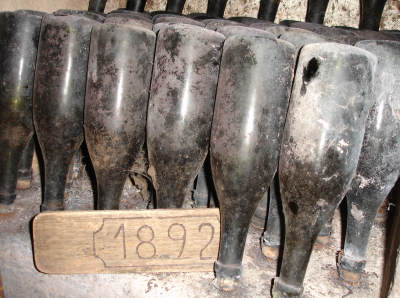
asked to push the metallic doors which close the
In a tasting cellar room, we tasted :
Moët 1999 : very precise and lovely champagne (I have driven the Ferrari) with the typical signature of Moët made of smoked and caramel taste. A really elegant champagne.
Moët 1983 : many signs are absolutely lovely. I was a little annoyed by a trace of metallic tastes.
As Richard Geoffroy talked only of years and not name, I asked if we were tasting Dom Pérignon and Richard answered to me that I should grow up to be allowed to taste the Dom (this is a joke as he intends that we make a private tasting as this one was organised for many people).
The Moët & Chandon 1962 was disgorged in front of us. It took three tries to succeed. When I proposed to take the two unopened away to help them to keep the room clean I did not receive any approval. So I knew that these bottles were not lost for everyone.
The 1962 is something fantastic. The smell was immediately of rose and of jam of rose. The taste was very floral and fruity. But what struck me, as a characteristic of this age, is the perfect integration of every component, which allows the champagne to be very long.
The Moët & Chandon 1952 disgorged in the same instant is magnificent, and completely opposite to the 1962. The younger is a flower, the older is a pure wine. It is the exact definition of champagne. And this is incredible that such a difference can exist.
But when sipping the two, I could see distinctly the signature of Moët, with obvious characteristics of smoke, caramel, sugared spiced bread.
A lovely tasting.
Then we had a lunch by the “orangerie” of the chateau, in a lovely “à la française” garden designed by Isabey, a French painter. We drank Moët Brut Imperial which I found lovely, a Phélan Ségur 1993 which was charming and tasty.
Jean Berchon, with a great sense of hospitality offered me a glass of Richard of Hennessy a magnificent cognac made with some alcohols of 150 years. One of the greatest cognacs.
When the noise of some 12 cylinders covered our farewell words, we knew that we had spent a lovely week-end, due to the generosity of a wonderful house of champagne.
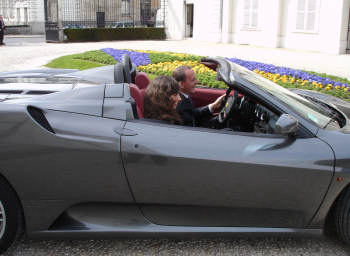
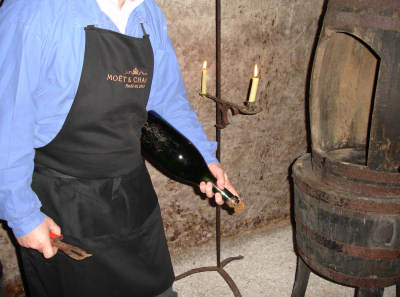
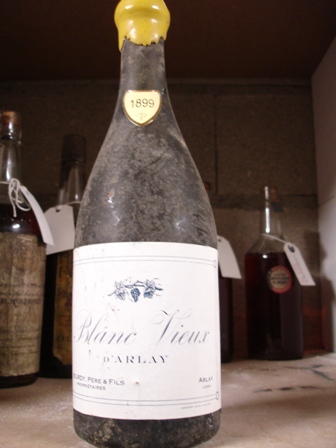
Blanc vieux d’Arlay Bourdy Père & Fils 1899.
Ce vin est exceptionnellement bon. Je suis amoureux de cette étiquette à la simplicité évocatrice de perfection.
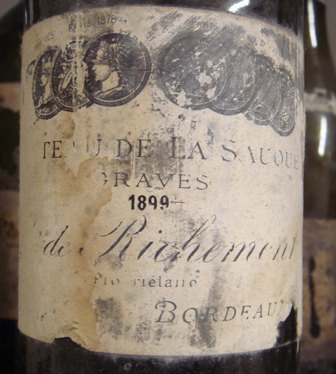
Chateau de la Sauque 1899, vin de Graves qui a sans doute disparu. Bouteille d’un ami ouverte lors d’un dîner de lancement de wine-dinners, avant le N° 1, en décembre 2000.
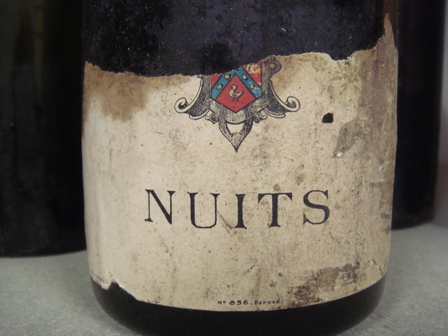
The French « Académie du vin de France » was founded in 1933 by Edmond Sailland called Curnonski (just a short note on this name. Edmond was in a period when it was popular to be either Russian or from Poland: Nijinski was a famous dancer. Wanting to find a pseudonym, he decided that it should finish by “ski” to be as the mode required, and found that in Latin language it would be : “why not ski?”, which is “cur non ski,” so Curnonski). The idea of the Academy was to have representatives of the best wines in France to talk to the government or to the press. This club was sort of a lobby. They have working sessions and an annual dinner, and they made me the pleasure to invite me for the last four annual dinners. Some people being not wine producers are there like Alain Senderens or Alain Dutournier, two famous chefs, and some people are considered as friends of the Academy like the journalist Bernard Pivot, a man who helped a lot the French literature and language. We are very few to have this honour.
It begins by one and a half hour of wine tasting of their latest production, so 2003 or 2004, and then, there is a great dinner by restaurant Laurent.
Aubert de Villaine, owner of Romanée Conti came very early to make a very serious analysis of every wine, wanting to be before the crowd which will not allow exploring all the wines. His wife Pamela prefers to talk with friends. Some nice wine makers comment their wines. I meet Beatrice Cointreau, represented by her champagne Gosset. She told me that she would attend my dinner in June, and would bring a very old alcohol.
I did not notice precisely the years of the wines or the precise appellation, but here are some remarks :
The Meursault Clos de la Barre Comtes Lafon 2003 is of an extreme subtlety, very elegant
The Puligny Montrachet Les Pucelles Domaine Leflaive 2003 has a power to explode in the mouth, which is very different from:
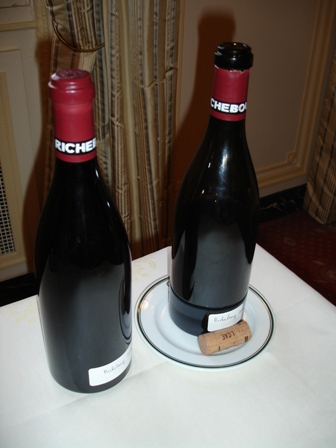 Hermitage white Chave 2003 which is a powerful but pushing on one line like in the sport play rugby, when the Puligny explodes
Hermitage white Chave 2003 which is a powerful but pushing on one line like in the sport play rugby, when the Puligny explodes
The Corton Charlemagne Bonneau du Martray 2003 seems to be not completely formed. It promises a lot.
In one room for reds at the first floor of restaurant Laurent, the samples are not to be ignored:
The Richebourg Domaine de la Romanée Conti 2004 is very highly emotional. The smell evokes highness. And in mouth the sensuality is extreme.
The Hermitage Chave red 2003 is a bomb. The smell is of a black berry very green, combined with a huge pepper. It is amazing how it invades the mouth.
On the contrary, the Volnay Santenots-du-Milieu Comtes Lafon 2003 is an angel. It is a poem. All in it is delicious, like a noble discussion between people of the 18th century in Versailles.
So, three expressions of completely different red wines, all of them expressing something very intelligent.
I drink a Pol Roger 1998 in magnum, a Gosset of a special cuvee 1999 and I go to try Chateau Haut-Brion 2004. The nose is very noble, very exciting. In mouth it is more a promise than a great wine.
In the room for sweet wines, I drink a Vouvray Huet Mont du Milieu 2004, very generous and natural, a Riesling VT Zind-Humbrecht probably 2004 which is elegant and a little more linear. The wine of Cauhapé 2003 is expressive, but invaded by sugar, and the Chateau de Fargues 2001 wins easily as Alexandre de Lur Saluces had chosen to show a very great year, a success for Fargues as it is for Yquem.
We go to our table, and at my table are, on my right Jean Hugel the young dynamic man being 81 years old and who talks endlessly, on my left, Alexandre de Lur Saluces, and on the left of Alexandre, François Peyraud, the owner of Domaine Tempier in Bandol. I talked mainly with these three gentlemen as the form of the table did not allow to talk with people being farer, as the general noise was great.
The dinner prepared by Philippe Bourguignon and Alain Pégouret was :
asperges vertes de Provence en feuilleté et homard juste saisi, sauce coraillée
filets de rougets relevés au safran, moelle, sauce matelote
morilles étuvées et délicate « royale », cappuccino
abbaye de Cîteaux, Saint-nectaire fermier, roquefort Carles
Litchis et faises des bois en arlettes croustillantes, glace au lait d’amandes
mignardises et chocolats.
As I know very well Philippe, I knew immediately which intentions of combinations were behind every choice. All the wines were from 1997.
The Riesling « Clos Winssbuhl » Zind-Humbrecht 1997 was for me a little limited, but Jean Hugel made compliments about its genuineness, so, he is the expert on such wines. I will trust in him.
The Puligny-Montrachet « les Combettes » Domaine Leflaive 1997 was absolutely bluffing by its power and its interest. Such a broad spectrum of flavours is rare. The Riesling was proper on the asparagus, and the Puligny went admirably with the lobster.
On the red fish, how would react the Bandol « Cabassaou » Domaine Tempier red 1997, as it was associated to the Château Haut-Brion 1997 red. The Bandol behaved well. The Haut-Brion as a magnificent nose, and has been the only wine of this dinner to express the specific limits of the year 1997. Every other 1997 performed, but the HB did not. There is a reason for that : I know quite well HB in good years. So the difference of 1997 with other years was more obvious to me.
The Bandol has not a structure as precise as the HB but was warm enough in its heart to shine on the fish. The sauce was a little too aggressive for me. I would have preferred that the meat of the fish would have been left more free to show itself. It would have enlarged the two wines.
Alexandre and Jean know me, and they know that I can be enthusiast. When they saw me being tetanised by the incredible beauty of the next course, they were anxious on my health.
I was enjoying one of the greatest possible combinations which exist.
The vin jaune, Château d’Arlay, Côtes du Jura 1997 formed with the cappuccino of morels an unforgettable match. It was heaven, pure heaven. I was on a white cloud. Immense.
On the three cheeses, three wines.
The Corton de Bonneau du Martray red 1997 is an extraordinary wine. All in it is pure grace. So light, so romantic, so refined, it has every possible weapon of soft seduction. A great wine;
The Corbin-Michotte Saint-Emilion 1997 comes from a castle where wine is always well made. But I was not surprised.
The Château de Fargues 1997 is purely delicious. It was provoked by a Roquefort which is creamy but very powerful. It was a fight – delicious – but not a real combination of pleasures.
The dessert, very exact, went well with a very high class wine : the Gewurztraminer Sélection de Grains Nobles (SGN) Hugel 1997. This is elegant, powerful, but is airy. This is the secret of these perfect Alsatian wines.
At the beginning of the dinner, the president of the Academy, Jean Pierre Perrin of Beaucastel, had made a very fighting speech talking about international taste versus French cultural tradition for wine. At the end of the dinner, Jacques Puisais, a true gastronome, made a very poetic speech commenting all the wines and combinations. I agreed on almost every points except one : I am not in favour of the bread with cheese when wine is concerned. I prefer the weddings for two, to the weddings for three.
What would be my ranking for tonight?
1 – the Arlay yellow wine, as it jumped to the sky due to the match with the food
2 – the Corton Bonneau du Martray for its elegance made of finesse
3 – the gewürztraminer Hugel as it combined power and lightness
4 – the Puligny Leflaive, as its palette of tastes was extremely shining.
And the wine of the night, for me, but I pretend to no objectivity, has been the Richebourg DRC 2004. A dream.
I noticed during this meeting that many people read the bulletin that I send every week on my adventures. They made nice comments.
I am very proud to be accepted in a group where are people making wines like Romanée Conti, Haut-Brion, Leflaive, Chave, and so many others.
I have spent a magnificent moment.